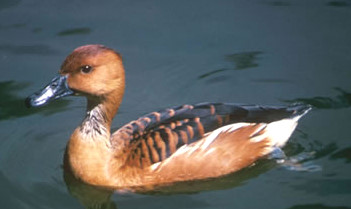Fulvous Whistling-Ducks, formerly known as Fulvous Tree Ducks, are among the most widespread waterfowl in the world, found throughout tropical and subtropical areas of Africa, Asia and the Americas, especially in rice-growing regions. These birds consume a diet rich in moist-soil and aquatic plant seeds; such as rice seeds and aquatic invertebrates. These food items are usually gathered while dabbling at or below the water level. (Holman and Lee 2001).
DISTRIBUTION. During the 1987-1992 field work seasons of the TBBA project, researchers found breeding records for Fulvous Whistling-Ducks in the Coastal Prairies and South Texas Brush Country regions (see the region map in Lockwood and Freeman [2004]). The relative abundance of the population is high in Texas, especially in the southern part of this state where the Raymondville (Willacy County) route of the North American Breeding Bird Survey (BBS) recorded an average of 28 of these ducks, the second highest in the United States, during the same period as the TBBA filed work (Price et al. 1995). TBBA atlasers found 10 of the 18 confirmed records in latilongs 26097 and 26098 in this area.
The Texas population continues east into the coastal prairies of Louisiana. These ducks also breed in southern California and south on the east and west coasts of Mexico. Other populations are resident in south Florida, the West Indies and locally in Central and South America, the Hawaiian Islands and in Africa and Asia.(Howell and Webb 1995, Am. Ornithol. Union 1998, Holman and Lee 2001, Sauer et al. 2007).
SEASONAL OCCURRENCE Fulvous Whistling-Ducks are mainly summer residents in Texas though some overwinter. Spring migrants have been reported between February 12 and May 30, with most arrivals in early to mid-March. The breeding season extends from early May to late October, based on egg collection dates from May 10 to September 16 and downy young present as late as October 19. Southbound migrants depart between August 6 and November 20 (Oberholser 1974, Lockwood and Freeman 2004). Data from southwest Louisiana indicates a peak breeding season from early April to late August (Holman and Lee 2001).
BREEDING HABITAT. In Texas Fulvous Whistling-Ducks are found in grassy freshwater marshes and ponds (Oberholser 1974). In southwest Louisiana the usual breeding habitat is rice fields (Holman and Lee 2001). and in Mexico most are found in open marshes, flooded fields and lagoons (Howell and Webb 1995). Nests are often placed on levees, dikes, flooded fields and rafts. Nests are usually in dense vegetation and weedy rice fields are strongly preferred to weedless fields. Nests are constructed of surrounding vegetation, such as rice straw in rice fields. The resulting bowl, either on the ground or a few inches above water, is lined with grass and forbs. The mean outside diameter is about 36 (range 30-44) cm (14 [range 12-18] in), inside diameter about 25 (range 17-27) cm (10 [7-11] in) and depth 7-12 cm (3-5 in; Harrison 1979, Holman and Lee 2001).
In Texas the female usually lays about 10 (range 6-16) smooth, white or buffy white eggs, stained with shades of buff. Incubation, starts after the clutch is complete, lasts 24-26 days and, is shared by the parents. The incubation period may stretch to as long as 44 days when a clutch is enlarged by brood parasitism. After hatching the downy young feed themselves, although their parents brood them for a few days and remain with them at least until fledging at about 63 days. Most parasitism is done by other Fulvous Whistling-Ducks, but Redheads (Aythya americana) are also a brood parasite (Harrison 1979, Holman and Lee 2001).
STATUS. Lockwood and Freeman (2004) consider Fulvous Whistling-Duck a common summer resident in the Coastal Prairies. Their historic breeding distribution (Oberholser 1974) is generally similar to the TBBA map, suggesting little or no change has occurred in the breeding range of this species in Texas. BBS data from 17 routes in this state provide a statistically significant annual population change for 1980-2006 of +16.3% (Sauer et al. 2007). This information suggests the future of Fulvous Whistling-Duck in Texas is secure, in spite of the adverse effects of hunting and pesticides (Holman and Lee 2001).
Text by Robert C. Tweit (2008)
Literature cited.
American Ornithologists’ Union. 1998. Checklist of North American birds, 7thed. Am, Ornithol. Union, Washington, DC.Harrison, H. H. 1979. A field guide to western birds’ nests. Houghton Mifflin, Boston, MA.
Holman, W. L. and S. A. Lee. 2001. Fulvous Whistling-Duck (Dendrocygna bicolor), The Birds of North America Online (A. Poole, Ed.). Ithaca: Cornell Lab of Ornithology; Retrieved from: http://bna.birds.cornell.edu/bna/species/562Howell, S. N. G. and S. Webb. 1995. A guide to the birds of Mexico and northern Central America. Oxford University Press, New York.

